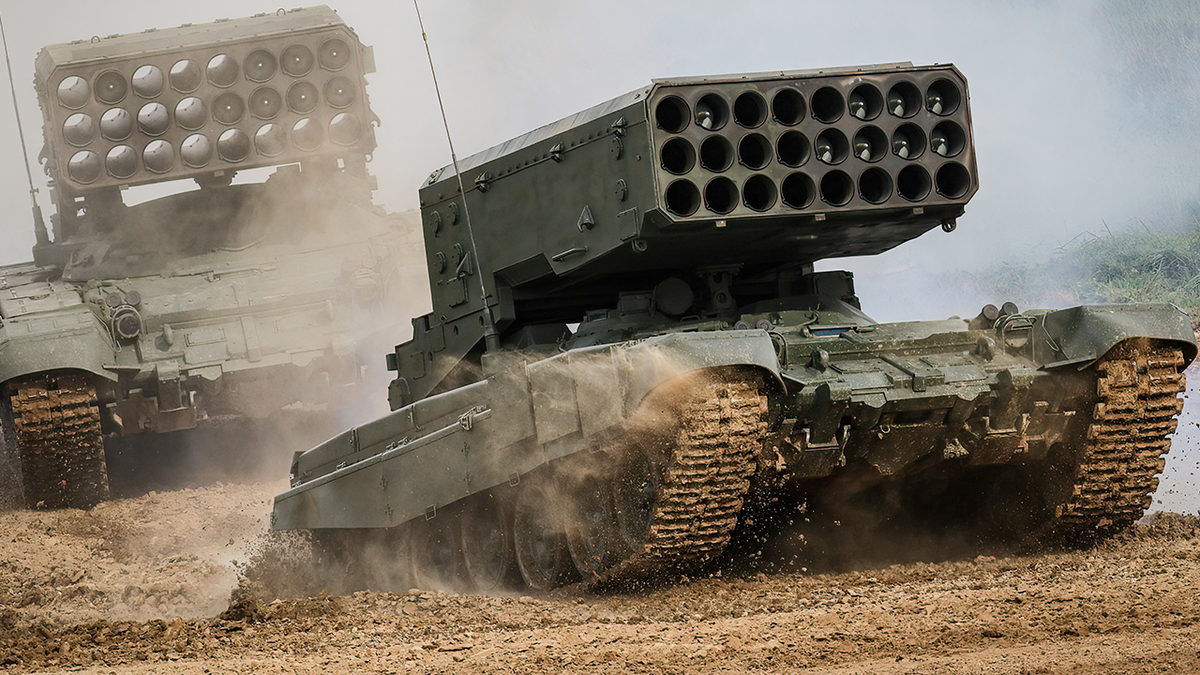Reports of vacuum bombs used on Ukrainian citizens
Col. Jay Voorhees weighs in on the Russia-Ukraine war as it enters tenth day.
Russia has confirmed its use of a thermobaric weapon system, or "vacuum" bombs, during Putin's invasion of Ukraine, the UK Ministry of Defense said Wednesday.
Vacuum bombs disperse explosive material over a large area that uses surrounding oxygen as fuel when it detonates, creating a blast wave that lasts far longer than conventional explosives. Thermobaric bombs are capable of sucking the air out of person's lungs, causing them to fill with liquid, or causing a person's lungs to rupture or explode.
"The impact of the [TOS-1A] is devastating," the UK Ministry of Defense said in a video. "It can destroy infrastructure and cause significant damage to internal organs and flash burns, resulting in death to those exposed."
House Speaker Nancy Pelosi, D-Calif., said that she discussed Russia's use of vacuum bombs with Ukrainian President Volodymyr Zelenskyy on Wednesday.
"We talked about weapons that Putin is using, weapons prohibited in the Geneva Conventions, including cluster bombs and vacuum bombs, which caused severe suffering," Pelosi told reporters.
RUSSIA INVADES UKRAINE: LIVE UPDATES
Pentagon Press Secretary John Kirby, meanwhile, said Wednesday afternoon that he has seen "no indications" that Russia has used thermobaric weapons in Ukraine.

MOSCOW, RUSSIA - 2021/08/25: Russian Army TOS-1A ‘Solntsepyok (Blazing Sun)’ multiple rocket launcher and thermobaric weapon mounted on a T-72 tank chassis seen during the annual Army Games defense technology international exhibition. (Photo by Leonid Faerberg/SOPA Images/LightRocket via Getty Images)
Oksana Markarova, Ukraine's ambassador to the United States, originally told reporters on Feb. 28 after meeting with Congress that Russian forces used a vacuum bomb.
"They should pay, they should pay a heavy price," she said at the time.
U.S. Ambassador to the United Nations, Linda Thomas-Greenfield, said on March 2 that Russia has moved vacuum bombs into Ukraine, accusing Putin of increasing "the brutality of its campaign against" the country.
"We have seen videos of Russian forces moving exceptionally lethal weaponry into Ukraine," she said in remarks at the UN. "That includes cluster munitions and vacuum bombs – which are banned under the Geneva Convention."
Human Rights Watch explains that vacuum bombs are "prone to indiscriminate use" due to their large blast radius.
"In urban settings it is very difficult to limit the effect of enhanced blast weapons to combatants, and the nature of enhanced blast weapons makes it virtually impossible for civilians to take shelter from their destructive effect," the organization said.
Vacuum bombs, or fuel-air explosives, were developed by the United States in the 1960s for use in Vietnam, according to the Center for Arms Control and Non-Proliferation.
RUSSIA'S CLAIM ON US AND UKRAINE BIOLABS 'ABSURD,' 'UNTRUE': US DEFENSE OFFICIAL
Russia used vacuum bombs in Chechnya in the 1990s and more recently during the Syrian civil war.

IDLIB PROVINCE, SYRIA – January 9, 2016: At least 70 people died in what activists said where four vacuum bombs dropped by the Russian air force in the town of Maaret al-Numan; other air strikes where also carried out in the towns of Saraqib, Khan Sheikhoun and Maar Dabseh, in Idlib. (REUTERS/Khalil Ashawi)
CLICK HERE TO GET THE FOX NEWS APP
White House Press Secretary Jen Psaki said last week that if Russia is using vacuum bombs, "it would potentially be a war crime."
International Criminal Court Prosecutor Karim Khan is investigating potential war crimes by Russia in Ukraine from 2013 to the ongoing invasion of Ukraine.






















